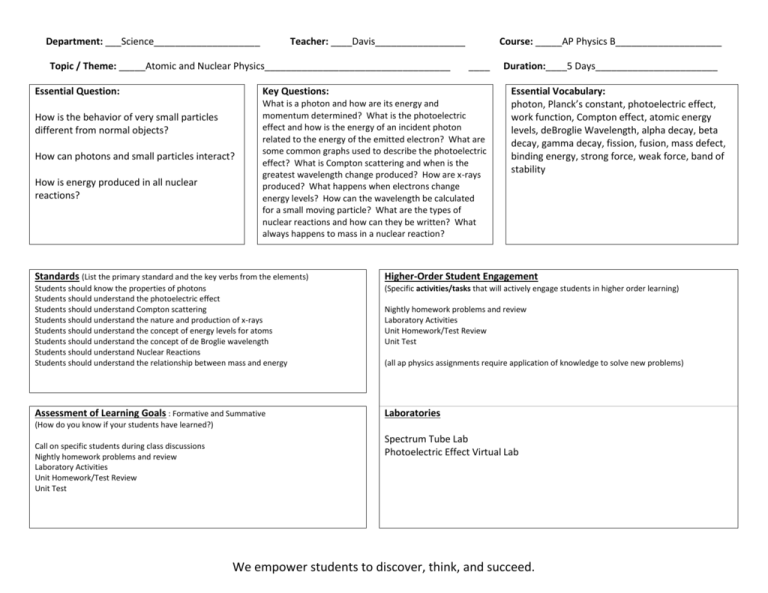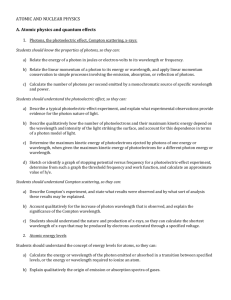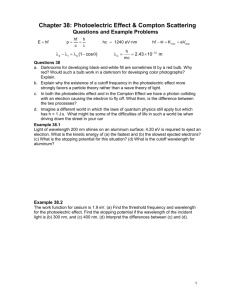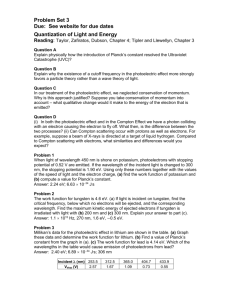Modern - Fulton County Schools
advertisement

Department: ___Science____________________ Teacher: ____Davis_________________ Topic / Theme: _____Atomic and Nuclear Physics___________________________________ Essential Question: ____ Key Questions: How is the behavior of very small particles different from normal objects? How can photons and small particles interact? How is energy produced in all nuclear reactions? Course: _____AP Physics B____________________ What is a photon and how are its energy and momentum determined? What is the photoelectric effect and how is the energy of an incident photon related to the energy of the emitted electron? What are some common graphs used to describe the photoelectric effect? What is Compton scattering and when is the greatest wavelength change produced? How are x-rays produced? What happens when electrons change energy levels? How can the wavelength be calculated for a small moving particle? What are the types of nuclear reactions and how can they be written? What always happens to mass in a nuclear reaction? Duration:____5 Days_______________________ Essential Vocabulary: photon, Planck’s constant, photoelectric effect, work function, Compton effect, atomic energy levels, deBroglie Wavelength, alpha decay, beta decay, gamma decay, fission, fusion, mass defect, binding energy, strong force, weak force, band of stability Standards (List the primary standard and the key verbs from the elements) Higher-Order Student Engagement Students should know the properties of photons Students should understand the photoelectric effect Students should understand Compton scattering Students should understand the nature and production of x-rays Students should understand the concept of energy levels for atoms Students should understand the concept of de Broglie wavelength Students should understand Nuclear Reactions Students should understand the relationship between mass and energy (Specific activities/tasks that will actively engage students in higher order learning) Assessment of Learning Goals : Formative and Summative Laboratories Nightly homework problems and review Laboratory Activities Unit Homework/Test Review Unit Test (all ap physics assignments require application of knowledge to solve new problems) (How do you know if your students have learned?) Call on specific students during class discussions Nightly homework problems and review Laboratory Activities Unit Homework/Test Review Unit Test Spectrum Tube Lab Photoelectric Effect Virtual Lab We empower students to discover, think, and succeed. GPS Standards (Optional) V. ATOMIC AND NUCLEAR PHYSICS A. Atomic physics and quantum effects 1. Photons, the photoelectric effect, Compton scattering, x-rays a) Students should know the properties of photons, so they can: (1) Relate the energy of a photon in joules or electron-volts to its wavelength or frequency. (2) Relate the linear momentum of a photon to its energy or wavelength, and apply linear momentum conservation to simple processes involving the emission, absorption, or reflection of photons. (3) Calculate the number of photons per second emitted by a monochromatic source of specific wavelength and power. b) Students should understand the photoelectric effect, so they can: (1) Describe a typical photoelectric-effect experiment, and explain what experimental observations provide evidence for the photon nature of light. (2) Describe qualitatively how the number of photoelectrons and their maximum kinetic energy depend on the wavelength and intensity of the light striking the surface, and account for this dependence in terms of a photon model of light. (3) Determine the maximum kinetic energy of photoelectrons ejected by photons of one energy or wavelength, when given the maximum kinetic energy of photoelectrons for a different photon energy or wavelength. (4) Sketch or identify a graph of stopping potential versus frequency for a photoelectric-effect experiment, determine from such a graph the threshold frequency and work function, and calculate an approximate value of h/e. c) Students should understand Compton scattering, so they can: (1) Describe Compton’s experiment, and state what results were observed and by what sort of analysis these results may be explained. (2) Account qualitatively for the increase of photon wavelength that is observed, and explain the significance of the Compton wavelength. d) Students should understand the nature and production of x-rays, so they can calculate the shortest wavelength of x-rays that may be produced by electrons accelerated through a specified voltage. 2. Atomic energy levels: Students should understand the concept of energy levels for atoms, so they can: a) Calculate the energy or wavelength of the photon emitted or absorbed in a transition between specified levels, or the energy or wavelength required to ionize an atom. b) Explain qualitatively the origin of emission or absorption spectra of gases. c) Calculate the wavelength or energy for a single-step transition between levels, given the wavelengths or energies of photons emitted or absorbed in a two-step transition between the same levels. d) Draw a diagram to depict the energy levels of an atom when given an expression for these levels, and explain how this diagram accounts for the various lines in the atomic spectrum. 3. Wave-particle duality: Students should understand the concept of de Broglie wavelength, so they can: a) Calculate the wavelength of a particle as a function of its momentum. b) Describe the Davisson-Germer experiment, and explain how it provides evidence for the wave nature of electrons. B. Nuclear Physics 1. Nuclear reactions (including conservation of mass number and charge) a) Students should understand the significance of the mass number and charge of nuclei, so they can: (1) Interpret symbols for nuclei that indicate these quantities. (2) Use conservation of mass number and charge to complete nuclear reactions. (3) Determine the mass number and charge of a nucleus after it has undergone specified decay processes. b) Students should know the nature of the nuclear force, so they can compare its strength and range with those of the electromagnetic force. c) Students should understand nuclear fission, so they can describe a typical neutron-induced fission and explain why a chain reaction is possible. 2. Mass-energy equivalence: Students should understand the relationship between mass and energy, so they can: a) Qualitatively relate the energy released in nuclear processes to the change in mass. b) Apply the relationship ΔE = (Δm)c2 in analyzing nuclear processes. We empower students to discover, think, and succeed.







